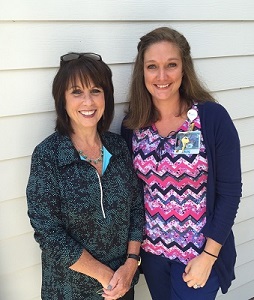What is a Concussion?
By Dr. Ava Hudson, Novant Health Lakeside Family Physicians

It’s not surprising that concussions are the most common head injury in contact sports, but what exactly is a concussion?
Concussions are a type of traumatic brain injury (TBI), which result in a temporary disturbance in brain function. They’re caused by a bump, blow, or hit to the head, causing the brain to rapidly move back and forth inside the skull. This rapid movement can result in chemical changes in the brain and sometimes damage to brain cells.
It is important to know the signs and symptoms of a concussion. Signs and symptoms typically present soon after the injury occurs. A concussion can cause difficulty thinking clearly, headaches, fuzzy or blurred vision, irritability, sleep disturbances, difficulty concentrating, sensitivity to light or noise, nausea, dizziness and more.
In some cases, symptoms may not be noticed for days or weeks after the injury.
In rare cases, a dangerous accumulation of blood may form and push the brain against the skull. Some “danger signs” require immediate medical attention if displayed after a bump, blow or jolt to the head or body:
- Decreased coordination, numbness or weakness
- Headache that worsens or persists
- Repeated vomiting or nausea
- Slurred speech
- An enlarged pupil in one eye
- Look very drowsy or cannot be awakened
- Cannot recognize people or places
- Unusual behavior
- Loss of consciousness
Most children and teens with a concussion feel better within a couple of weeks, but it’s important to note that concussions affect everyone differently. As a result, some may have symptoms that last for months or longer. It’s important to talk to your child’s healthcare provider if their symptoms do not go away or if they worsen once your child returns to his or her regular activities.
If you think your child has a concussion, remove them from sports and activities to prevent more injury. Your child should be seen by a health care provider and should only return to play with permission from a provider experienced in evaluating concussions.
Ask your child’s health care provider for written instructions on helping your child or teen return to school for nurse/teachers and return to play instructions for coach and/or athletic trainer.
Sports are great way for children and teens to stay active and healthy. It is important to talk with your child about concussions and how to prevent them, because prevention is key. Encourage them to report any concussions symptoms to a parent or coach and to always follow the safety rules of their sport.
Dr. Ava Hudson works as a physician at Novant Health Lakeside Family Physicians in Mint Hill, North Carolina. She is an internal medicine and pediatric physician with subspecialty in sports medicine.
This blog was produced in partnership with Charlotte Parent. Click here for the original post and other parenting resources.
Enjoy the Holidays With Your Special Needs Child
By Dr. Dawn O’Malley, Alexander Youth Network

There is a reason people often say the holidays are such a stressful time. Any time we have increased demands on our time, big changes in our daily routine and high expectations, we are at risk for increased stress. This is true even when the activities we are doing are meant to be fun.
For kids, particularly those who struggle with emotional and behavioral issues, the holidays are particularly stressful. Loud music, blinking lights, sugary foods and late nights can wreak havoc on their sensitive systems. There are some things you can do to limit the stress and make sure everyone has fun this holiday season.
- Keep your and your child’s daily routine as regular as possible. Keeping the same bedtimes, meal times and recreation times reduces stress. Our body and mind do best with routine. When we make lots of changes to our daily routine, it creates stress. This is true for your child’s medication as well. Do not stop giving medication over the holidays. Children’s emotional needs don’t take a break during vacation times.
- Limit the number of parties and events that you attend. Pick the events that are most important to you and your child and forego the rest. The more events, the greater number of demands for you and your child. Consider arranging child care so that you may attend an event that is most special to you without your child. If that isn’t possible, limit the amount of time that you spend at each event. For young children, even one hour at a party is a long time.
- Discuss holiday events and expectations before attending. Sit down with your child and explain the event you are attending and the behavior you expect. Keep it short and simple: “We are attending a holiday party at Aunt Dottie’s this evening. We will be there for two hours and we will have dinner there, then we’ll come home. I expect that you will play with your cousins in the family room, while I sit and talk with my sisters. Come and get me if your cousin Lou teases you.”
- Be prepared. Bring a special toy, book or game for your child to play alone or at your side during holiday events. Having something from home can make children feel more comfortable during potentially overwhelming situations. Allow your child to hide special toys out of reach, if people are coming to your house.
- Have an emergency escape plan. Be prepared to make a quick exit if you sense that your child is heading for trouble. Let your host know ahead of time that you may need to leave early to make leaving easier and ensure there aren’t any misunderstandings.
- Be realistic. The holidays are made even more stressful by the dozens of images of happy, care-free families we see on television ads this time of year. No family is without its challenges, be realistic about your expectations for the holidays. What does your family do best? Cook, sing, play? Plan your holidays around what you do most easily.
- You are your child’s greatest gift. Do you remember what gifts you received a year ago, two years ago, five? There’s a good chance you don’t. We tend to remember special moments shared with others, rather than things we received. Giving your child some of your individual attention and time stays with him or her much longer than a new toy.
Dr. Dawn O’Malley is a North Carolina Licensed psychologist and dlinical director at Alexander Youth Network, a leading provider of behavioral health care for children across North Carolina. Alexander Youth Network are experts in treating emotional trauma in children and helping kids cope with anxiety.
This blog was produced in partnership with Charlotte Parent. Click here for the original post and other parenting resources.
Sensory Processing Disorder: Is it Real?
By Bri VonLehmden-Kurcsak, Pediatric Occupational Therapist
 Is your child an especially picky eater? Does your son or daughter get upset about the clothes you pick out for him or her? Parents sometimes assume that their child is acting out when it may actually be a sign of an underlying issue. Sensory processing disorder, or SPD, is a complex brain condition where nervous system sensory signals don’t get organized into appropriate responses, according to the SPD Foundation.
Is your child an especially picky eater? Does your son or daughter get upset about the clothes you pick out for him or her? Parents sometimes assume that their child is acting out when it may actually be a sign of an underlying issue. Sensory processing disorder, or SPD, is a complex brain condition where nervous system sensory signals don’t get organized into appropriate responses, according to the SPD Foundation.
One study found that SPD affects one in 20 children’s daily life while other research suggested one in six children experience sensory symptoms that may be significant enough to impact everyday life functions. A person with the disorder can find it challenging to process information received through the senses and, therefore, react atypically. This, in turn, can affect the way an individual takes on routine tasks and may manifest in clumsiness, behavioral problems, anxiety and issues at school, which is why it is important to seek treatment.
Difficulty with emotional outbursts, misbehaving, difficulty learning or paying attention or delays in developmental milestones are things you may see in a child with SPD. Parents may wonder why their kids don’t like the texture of sand or are picky about their clothes or foods they eat. This can all be tied to SPD. Individuals with SPD can experience it through one sense or through multiple senses. Some people may over respond to a sensation and find clothing, touch, light or sound to be unbearable, while another individual with SPD may under respond and show little reaction to stimulation, even when it causes pain. Children who exhibit an appetite for a sensation in perpetual overdrive are often misdiagnosed as having attention-deficit/hyperactivity disorder (ADHD), according to the SPD Foundation.
Health care professionals may not always recognize these sensory issues. A pediatrician may evaluate a child and tell parents that he’s a typical boy and he’ll grow out of it, without addressing the integration issue, but even if the child does learn to tolerate the beach, he or she may never learn to integrate the smell, the touch or the sound, potentially creating additional sensory issues in the future.
What Causes SPD?
While a cause is still unknown, SPD occurs more often in people who have attention-deficit/hyperactivity disorder, autism and anxiety disorders. In a recent study, researchers, for the first time, identified a biological difference in the brain structures of children with the disorder.
Treatment is very personalized and can range from as short as just a few visits or longer, lasting months. The dangers are parents who try to treat SPD on their own, or kids who simply aren’t treated. People may think that their child has grown out of an issue. They may learn to tolerate that one issue, but if the underlying senses triggered aren’t properly integrated, it will most likely cause difficulties later. If you think something isn’t quite right, follow your gut, and push for a referral from your pediatrician to get a comprehensive evaluation. Treatment will be more effective, less intense and shorter in duration if addressed early on.
Bri VonLehmden-Kurcsak is a pediatric occupational therapist at Novant Health Rehabilitation Center specializing in sensory processing disorders, picky eaters and problem feeders, and the behavioral challenges that arise with developmental delays and autism spectrum disorders. She has extensive training and also serves as adjunct faculty at CPCC in the OTA program, teaching pediatric courses.
This blog was produced in partnership with Charlotte Parent. Click here for the original post and other parenting resources.
Understanding Referrals and Insurance
By Amy Combs and Mary Leigh Dickerson

If you have ever worked with the administrative staff of Pediatric Surgical Associates, then you know Amy Combs and Mary Leigh Dickerson. In addition to running the day-to-day operations of the practice, they process referrals and insurance, from prior authorizations to claims and beyond.
Amy and Mary Leigh have mastered the world of medical paperwork, which can be extraordinarily confusing.
For families confounded by codes and claims, here’s some helpful advice:
Step One: Getting the Referral
Getting a referral to a specialist is a decision made by you and your pediatrician. Your active involvement will minimize any miscommunication and increase the likelihood of a smooth referral process.
When referred by your primary care provider or pediatrician to a specialist, here are a few basic questions to ask:
- To whom am I being referred and why?
- What is the specialty and how does that connect to the other care I receive?
- Is the specialist someone your provider would use for his or her own child?
- Who at this office is sending the referral? (This makes it easier to follow-up if something gets lost in the shuffle.)
- What is the name and contact of the person to whom the referral is being sent?
- When can I expect to hear back?
Once the referral is made and the consultation is complete, the question about payment arises. This is when insurance comes into the picture.
Step Two: Getting Everything Covered
Since insurance is a third-party process, it can get very complicated. With so many different carriers and levels of care offered by each, it is challenging for your primary care office staff to determine if the office you are being referred to is in or out-of-network. Before any appointment is made, ensure the specialist accepts the company AND the type of plan. If your policy has changed at all, be sure to call ahead and ask. Once the appointment is over and the service has been delivered, there is no way to reverse the charges incurred.
Always:
- Know your carrier and the type of plan.
- Keep the latest version of your insurance card with you.
- Understand your deductible. That is how much you pay before insurance starts picking up the bill.
- Know if your plan has a co-insurance, which is different than a deductible. Often the co-insurance is a percentage that you “split” with the insurance company above, and beyond the deductible. If you have one, budget for it!
Once you have a plan in place for care, you may need prior authorization. Prior authorization is justification as to what you need and why you need it, so the insurance company can determine if it will be covered. Proceeding without prior authorization means that you accept and agree to pay for anything insurance does not pay.
Here are some other tips to avoid an unexpected bill:
- Ask the doctor’s office to estimate how much the procedure will cost.
- If your procedure is NOT covered by insurance, ask the office staff if they can call the insurance company and make an argument on your behalf.
- Understand that you are going to receive multiple bills from each party involved, including, but not limited to, the specialist, anesthesiologist and hospital.
- Hospital costs (otherwise known as facility fees) are the most expensive, and although those cannot be estimated or controlled by the doctor’s office, you can call the hospital and request an estimate.
Step Three: Getting Help When There’s a Problem
With so many moving parts, sometimes things happen. The office might apply the wrong insurance code to the actual care received, or the insurance company might send the wrong amount to the provider.
If this does occur, be ready:
- Keep the Explanation of Benefits forms that come in the mail– don’t throw them away.
- Have those papers handy when your bill comes and match up the charges to make sure that they are correct.
- Call the insurance company and ask for clarification if you do not understand. Take notes!
- If the insurance company cannot explain the charge and the doctor cannot either, you can dispute it.
Your doctor’s office should be there to help and not inhibit. Good practices will work with you and call the insurance company as many times as it takes. Your surgeon or specialist should be there for you and your family for better or worse; the office staff should be too.
This blog was produced in partnership with Charlotte Parent. Click here for the original post and other parenting resources.
Prevent Childhood Obesity by Creating a Healthy Home
By Dr. Jennifer G. Hudson, Salisbury Pediatrics

Childhood obesity is an increasing epidemic. In North Carolina, almost one in three children is either overweight or obese. How can you tell if your child is one of them?
Pediatricians use a tool called the Body Mass Index (BMI) to assess whether a child is overweight or obese. The BMI is calculated based on height and weight, and then graphed on a chart based on the child’s age. A BMI between five and 85 percent is considered normal. A BMI from 85 to 95 percent is considered overweight, and a BMI above 95 percent is considered obese. You can find a helpful tool at nccd.cdc.gov to calculate your child’s BMI. Using the BMI chart helps to reveal a problem before it is obvious to a parent or even to a physician.
What can we do to prevent and/or treat childhood obesity in our children? It begins with prevention, and it’s never too late to reset old habits and create a new healthy lifestyle in your home. If your child is a healthy weight, it is still important to maintain good habits to prevent obesity. Here are some guidelines for keeping your children healthy:
- Make fruits and vegetables a key part of your family’s diet. Avoid processed foods and eat more whole foods.
- Eat together as a family. Turn off the TV. Dinnertime is a great opportunity for parents to model healthy eating behaviors, and it provides quality family bonding time.
- Limit electronics to two hours or less daily. Electronics are addictive, so set limits for your child. And be sure to serve as a role model and limit your own use of electronics.
- Establish a consistent sleep routine. Set a bedtime and turn off all electronics off at least one hour before bed. Insufficient sleep increases hormones for hunger cues and can lead to unhealthy eating behaviors.
- Water is the best beverage. Avoid sugary drinks. If your kids don’t have juice, soda, or sports drinks at home, then water becomes the best choice.
- Avoid fast food and limit eating out. The goal of restaurants is to make sure you want to come back, not necessarily to keep you healthy. When you cook at home, you know exactly what you’re feeding your family.
- Make sure your children are getting at least one hour of daily activity. Turn off the electronics and encourage everyone to play outside. Turn on music for dancing. Play sports. Take a family walk. Ride bikes. Keep it fun and keep your kids active.
- Banish junk food from your home. A treat should be a special event, not a daily event. If you have apples and chips sitting next to each other, who among us wouldn’t pick the chips? But if the choice is between apples or oranges, you’ll end up with a healthy snack. You can’t sneak junk food or sugary drinks if they’re not in the house.
- Love your child by setting limits and teaching them to embrace a healthy lifestyle.Too often, parents and grandparents want to show love by showering children with sweets and junk food. I once heard a 3-year-old child say to her mom, “You don’t love me because you won’t give me ice cream.” Let them know you love them by saying no to junk food.
The easiest way to keep your children healthy is to set up effective routines at a young age. If you have already developed poor habits in your family, now is the time to change them. Just be prepared for resistance. The behavioral battle to turn around unhealthy habits can feel overwhelming. Persistence and modeling good healthy behaviors can help change your children’s mindset about food, exercise and health.
That said, if you’ve created a healthy home environment but your child is still battling with weight issues, talk to your pediatrician. They may need to do bloodwork to assess for other issues causing weight gain. Your doctor can also offer additional tools to help you keep your child healthy, including assistance with behavioral issues, recommending a dietician or putting you in touch with local community support. As parents, we are never alone. We all have the support, the ability and the responsibility to develop a healthy lifestyle for our children that will last a lifetime.
Dr. Jennifer Hudson is a pediatrician at Salisbury Pediatrics and mother of three teenagers. She has run the nutrition clinic at Salisbury Pediatrics for the past 12 years, working one-on-one with parents and children to create healthy lifestyles.
This blog was produced in partnership with Charlotte Parent. Click here for the original post and other parenting resources.
Headed to the Hospital?
 Chances are if your child has been admitted to Hemby Children’s Hospital (Novant Health) or Levine Children’s Children Hospital (Carolinas Healthcare System) for a pediatric surgical problem, you have probably met Charlotte Steedly or Ronale Johnson. These extraordinary nurses are the glue that holds every piece of your hospital experience together. They make it a point to meet every family who needs general pediatric surgery, and they ensure the surgeon’s instructions are given to every part of the team.
Chances are if your child has been admitted to Hemby Children’s Hospital (Novant Health) or Levine Children’s Children Hospital (Carolinas Healthcare System) for a pediatric surgical problem, you have probably met Charlotte Steedly or Ronale Johnson. These extraordinary nurses are the glue that holds every piece of your hospital experience together. They make it a point to meet every family who needs general pediatric surgery, and they ensure the surgeon’s instructions are given to every part of the team.
For parents and caregivers who are headed to the hospital, here are a few words of advice from Charlotte and Ronale:
1. If you have a concern, never hesitate to share it with multiple members of the team. If you tell us “everything is fine,” then we might miss an opportunity to help.
2. Write things down, and keep a notebook with you if possible. Document every medication, the type and date of any previous surgery (or surgeries), and any symptoms of concern. Keep the notebook current so you don’t forget the details. If you want to look something up, ask the doctor to write down the exact spelling. Some doctors will even draw sketches/pictures to help you understand. These are worth keeping for reference when you need to explain the issue to a family member.
3. There are no dumb questions, but there are bad answers. Ask anything. If someone talks over your head in overly technical language, ask him or her to back up and explain it in different terms until you understand.
4. Not sure who does what? When people come into your room, ask them their role and where they fit into your treatment picture. Be sure to check the badge for their department – although all doctors are MDs and all nurses are RNs, they might not be on the same team.
5. Here are the most common abbreviations we are asked to clarify:
- Medical Doctor (could be a surgeon, resident or someone working on the case)
- PGY – Post Graduate Year (indicates the number of graduate years in training)
- R – Resident (are MDs)
- PA – Physician Assistant
- MS – Medical Student
- RN – Registered Nurse
- NP – Nurse Practitioners (these nurses can write prescriptions)
- CNA – Certified Nursing Assistant (these professionals can take vital signs, like height and weight, and can help change diapers and give baths)
- CRNA – Certified Nurse Anesthetist
- OR – Operating Room
- NPO – Take nothing orally (NPO is from the Latin term “nil per os,” which translates to “nothing by mouth”)
- MSW – Medical Social Worker
- FACS – Fellow of the American College of Surgeons
- FAAP – Fellow of the American Academy of Pediatrics
- APSA – American Pediatric Surgical Association
It is our goal to treat your child as if he or she were our own. You can request and expect that from every member of your medical team.
This blog was produced in partnership with Charlotte Parent. Click here for the original post and other parenting resources.
It’s Complicated: Understanding Pediatric Specialization
 Learning modern medicine is like peeling an onion; the more you uncover, the more you find there is to learn. As a pediatric surgeon, I know how to perform a wide variety of surgeries. Whether repairing a hernia, removing an appendix, or creating and connecting an esophagus for a baby born without one, pediatric surgeons treat children of all ages with sometimes straightforward but often complex conditions affecting multiple organ systems of the body.
Learning modern medicine is like peeling an onion; the more you uncover, the more you find there is to learn. As a pediatric surgeon, I know how to perform a wide variety of surgeries. Whether repairing a hernia, removing an appendix, or creating and connecting an esophagus for a baby born without one, pediatric surgeons treat children of all ages with sometimes straightforward but often complex conditions affecting multiple organ systems of the body.
Although I know how to do many things very well, there are some procedures and disease processes that are best treated by someone who has spent their entire career focusing on a single area, whether a vital organ like the brain or heart, or a complicated or rare illness. Welcome to the world of specialization.
As my friend and colleague Dr. Andrew Schulman discussed in our last blog, “Healthcare is a Team Effort,” specialization is essential to top-quality medical care, but it does make the medical world more complicated. The key to avoid getting lost in the shuffle is to find a “Jack (or Jill) of all trades,” who is either leading the team or serving as your guide in making the important connections.
What to Expect
Most people who purchase a home hire a realtor. The realtor did not build the house, give you the money to buy it or notarize the sale, but their job is essential to helping you know where to go, what to expect and what you need to close. This kind of guidance is what a primary care physician should offer for your overall medical care.
If a child’s surgical condition requires a pediatric specialist (surgical or otherwise), it’s helpful to have a team to provide the connection, the referral, the follow-through and any support the family or treating physician might need.
Qualities to look for in a pediatric specialist:
- Resourcefulness: Even if the practice can’t assist, are they willing to help me find another that can?
- Teamwork: If the doctor I request is unavailable, who are the available partners? Do I trust them as much as the doctor I was originally referred to?
- Communication: If there are multiple doctors in the practice, are they all on the same page and sharing the necessary information?
- Clarity: Can they explain to me what needs to happen using clear language?
- Efficiency: Do they return calls and get paperwork where it should go?
- Availability: Are they easy to reach in an emergency?
- Personnel: Will the patient be seeing a doctor or a physician’s assistant? What are the qualifications of both?
Navigating health care is not for the faint of heart. I see many parents and caretakers who, out of necessity, have worked hard to understand everything from what insurance covers to which hospital system offers the best treatment for their child’s condition. Often these are the parents who have children with rare or complicated conditions. The resourcefulness of these parents never ceases to amaze me. They have learned how to successfully advocate for their children, but they shouldn’t have to do it alone. Neither should you.
Be sure to watch for the upcoming “Headed to the Hospital?” blog post that includes advice and observations from two exceptional nurses who provide the connections to ensure all pediatric surgical teams run like clockwork.
This blog was produced in partnership with Charlotte Parent. Click here for the original post and other parenting resources.
Healthcare is a Team Effort
 If you have ever admitted your child to the hospital, especially in an emergency situation, it can be an overwhelming, confusing and isolating experience. Patients will wonder, “Why are there so many different people coming in and out of here?” “Why am I getting asked the same question multiple times?” “Why does it take the doctor so long to come back?” and most commonly, “When can we go home?!”
If you have ever admitted your child to the hospital, especially in an emergency situation, it can be an overwhelming, confusing and isolating experience. Patients will wonder, “Why are there so many different people coming in and out of here?” “Why am I getting asked the same question multiple times?” “Why does it take the doctor so long to come back?” and most commonly, “When can we go home?!”
In the absolute best scenario, a hospital experience (especially one that involves surgery) should feel as though you are part of a well-oiled machine. Though you cannot see all the moving parts, there is a great deal of coordination happening behind the scenes to ensure your experience is as seamless as possible.
To begin with, it may feel as though you are being seen by 20 different people, but there are actually different teams that each specialize in a specific area of care and all are required to ensure the best experience for your child. Let’s use surgery as an example:
When you arrive and check in at the hospital with your child, you are first seen by the pre-operative team, consisting of a receptionist, technicians who take your vitals, and specialized pre-operative nurses. This team ensures that you have a clear understanding of what surgery your child is to receive that day, that all of the preparations and paperwork for surgery have been done correctly and that there are no new health concerns that could alter the surgical plan. This team is the first line in ensuring that your child receives a safe, successful operation.
Once the pre-operative team has done their job, the operative team takes over. This team consists of a circulating nurse, nurse anesthetist and anesthesiologist, scrub technician and your child’s surgeon. The circulating nurse is trained to ensure that the operating room is ready for your child, and verifies the information obtained by the pre-operative team (hence the redundant questions). The nurse anesthetist and anesthesiologist verify it is safe to proceed with anesthesia (usually involving more redundant questions), and ensure that your child’s pain, nausea and anxiety are all well-managed before, during and immediately after surgery. The scrub technician operates with your child’s surgeon, managing the instruments, and with the circulating nurse, ensures the operative environment is clean, sterile and safe for your child. The process is a well-practiced one, and has been well-coordinated with your child’s surgeon. Just prior to going back to the operating room, you should see your child’s surgeon, who discusses and confirms the information obtained by the pre-operative and operative teams, and will review the surgical plan with you. Once in the operating room, your child’s surgeon and the operating team work in a coordinated fashion to once again confirm that everything is safe to proceed. Many of these steps may seem redundant or inefficient, but they provide a system of checks, double checks and even triple checks to ensure maximum safety and a smooth operation.
When surgery is complete, your child is brought to the PACU (post-anesthesia recovery unit). Here is another team of nurses and assistants who are specially trained in managing a child’s emergence from anesthesia and surgery. The body’s process of emerging from anesthesia is a gradual one, marked by well-defined stages. The PACU team knows these stages and how to spot problems early. They are in close communication with the operative team, and are the first alert that closer attention may be needed. Stable breathing, well-managed pain and well-managed anxiety are just some of the things the PACU team is trained to monitor.
To make matters more complicated, not all of the people listed above may be employed by the same organization. For example, all the physicians at Pediatric Surgical Associates have operating credentials at both Novant Health and Carolinas Healthcare System. Depending on the procedure, the anesthesiologist might also be part of a different independent practice that is contracted by the hospital. And yes, this is why you receive bills from different providers after your hospital stay.
At face value, the whole process may seem overly complex. By the time I see families in the pre-operative area and repeat the same questions they have been asked several times already, they occasionally ask me, “I just answered those questions, don’t you know?” As I have explained performing surgery is a complex process, even for so-called routine procedures, and our highest priority is for a child’s safety. A safe and successful surgery requires multiple professionals who are specially trained for pre-operative, peri-operative and post-operative care, but who also overlap in their responsibilities to ensure no detail goes un-checked. Specialization is absolutely necessary to providing the very best medical care available, but that care is only effective if doctors, nurses, physicians assistants, primary care physicians, anesthesiologists, etc., are communicating and working as a team to ensure your child gets the best care.
Stay tuned for the upcoming post titled “It’s Complicated,” from my friend and colleague, Dr. Daniel Bambini. He will continue to de-mystify specialization and give you specific tips on what you can do to ensure your medical teams are talking to each other and including you in the conversation.
This blog was produced in partnership with Charlotte Parent. Click here for the original post and other parenting resources.
Circumcision: Is it Necessary?
By Dr. Joe Molitierno, Pediatric Urology Associates

In nearly a decade of practice as a pediatric urologist, I find that nothing generates more questions and anxiety for new parents like the subject of newborn circumcision. Parents are overwhelmed with the opinions of family members and friends who are more than happy to relate their experiences and impart their beliefs. Finding trustworthy and accurate information regarding the risks and benefits of circumcision, the procedure(s), and/or the potential complications is exceedingly difficult. I hope this article will shed some light on the subject.
Is circumcision medically recommended?
This is a difficult question to answer. Rarely is circumcision performed for a medical indication. The risk of urinary tract infection (UTI) is so low in baby boys that more than 100 circumcisions would have to be performed in order to prevent a single UTI. And the only true medical indications in infants include a history of UTI, urinary blockage or urinary reflux.
However, the American Academy of Pediatrics released the following policy statement in 2012:
“The health benefits of newborn male circumcision outweigh the risks and that the procedure’s benefits justify access to this procedure for families who choose it. Although health benefits are not great enough to recommend routine circumcision for all male newborns, the benefits of circumcision are sufficient to justify access to this procedure for families choosing it.”
While this may seem a little confusing, the opinion is that there are enough medical benefits to justify the decision for circumcision. However, if you don’t wish to circumcise your baby boy, this certainly doesn’t make you a bad parent.
Why do parents circumcise their children?
A variety of factors go into the decision to circumcise a baby boy. Often it’s as simple as wanting to have the baby look like his dad or his brothers. Sometimes it’s for religious reasons, as most Jewish and Muslim families have the procedure performed. Some cultures practice circumcision as a rite of passage to manhood. Many families who have immigrated to the U.S. have a circumcision performed to become more “American” and fully assimilate into their new culture. And some families note cleanliness and appearance as the reasons.
When should it be done? Who should perform it?
Infant circumcisions are often performed in the newborn nursery for the convenience of the families. As long as the baby is healthy and eating well, the procedure can be safely done before the family is sent home. However, if the child is not feeding well, is on the small side (weighing less than five pounds) or has any other medical issue such as low platelets or sepsis that might complicate the circumcision, it can be delayed for up to two months and still be safely performed in an outpatient setting.
In the hospital setting, circumcisions are performed by a variety of physicians. Charlotte is a unique city because a pediatric urologist can be requested to perform a newborn circumcision at any of the metropolitan hospitals. At the same time, pediatric surgeons, obstetricians and pediatricians routinely perform newborn circumcisions. Experience levels can vary, so ask the physician about their experience and comfort level with the procedure. Outside of the hospital, Jewish circumcision ceremonies are often performed by mohels, many of whom are also physicians.
In summary, circumcisions have been performed for centuries, and although they are not medically necessary in most cases, there is enough evidence to justify the practice of newborn circumcision. The procedure can be performed safely in the newborn nursery, but can be delayed up to two months and still be performed in an outpatient setting using the same methods. Most importantly, be assured that all of the methods used for newborn circumcision are equally safe when an experienced physician or trained provider performs the procedure.
Joe Molitierno, MD is a board-certified Pediatric Urologist who trained at both UNC Chapel Hill and Emory Schools of Medicine. He has been practicing in the Charlotte area for over nine years. He is a partner with Pediatric Urology Associates, PA and is the director of the Nocturnal Enuresis and Wetting Treatment (NEWT) center, the Carolinas first pediatric voiding dysfunction center.
This blog was produced in partnership with Charlotte Parent. Click here for the original post and other parenting resources.
Kids Get Hernias, Too
 “My child has a hernia? I thought that only happens to adults!” We frequently hear this from surprised parents in the office, but the answer is, “Yes, your child can get a hernia.” In fact, hernia repair is one of the most common operations for pediatric patients.
“My child has a hernia? I thought that only happens to adults!” We frequently hear this from surprised parents in the office, but the answer is, “Yes, your child can get a hernia.” In fact, hernia repair is one of the most common operations for pediatric patients.
So what exactly is a hernia? It is a hole in the abdominal wall musculature through which abdominal contents can protrude. There are three types of abdominal wall hernias that we routinely see in children:
1. Umbilical hernia
For newborns, after the umbilical cord stump falls off, the skin and muscle contract, closing the hole where the umbilical cord had been. If this process does not occur completely, a defect in the muscle persists. The skin of the belly button will have a soft bulge that can be pushed back in. These bulges, commonly referred to as “outie” belly buttons, are abdominal fat or intestines pushing up under the skin. Umbilical hernias will often close on their own in the first few years of life. Beyond age three or four, however, the defect will not close spontaneously and will likely require surgical repair. Most children with umbilical hernia undergo repair between age three and five. These operations are performed under light general anesthesia as out-patient procedures. Small incisions are made but are hidden in the belly button skin, and the entire procedure takes between 20 and 40 minutes. Most children have soreness for 48 to 72 hours but are usually back to normal within five to 10 days, depending on the age of the child and the size of the hernia.
2. Inguinal hernia and hydrocele
During fetal life, boys’ testes and girls’ ovaries develop high in the abdomen near the kidneys. They are connected to the groin by a cord-like structure called the gubernaculum, which guides their descent into the pelvis. In girls, the ovaries settle in the pelvis next to the uterus. In boys, the testes continue to descend through openings in the groin muscle and settle in the scrotum. In both boys and girls, a small opening in the groin muscle remains. Usually these openings close in infancy, but, in about four percent of boys and one percent of girls, the opening does not close properly, leading to an inguinal hernia or a hydrocele. (Learn the difference between the two.) In premature infants, inguinal hernia is much more common, appearing 30 to 40 percent of the time.
Inguinal hernias should be repaired within four to six weeks of diagnosis to avoid incarceration. Such hernias in children are not like those in adults, which often require closure with synthetic mesh. The operation in children involves tying off the sac-like projection of abdominal wall lining that passes through the inguinal canal, effectively closing the hole in the groin muscle. These operations are performed under general anesthesia through very small groin incisions and take less than an hour. Most children will be completely recovered within a week.
3. Epigastric hernia
These are small holes in the abdominal musculature between the belly button and the breast bone. Small bits of internal fat from the abdomen protrude through the hole, creating a knot under the skin that is most apparent when the child is standing up. The herniated fat can go in or out, or it may remain stuck within the hernia all the time. Epigastric hernias are usually not bothersome to children, but they do not go away on their own and slowly enlarge over time. Elective repair is recommended, not just for cosmetic reasons, but to avoid long-term problems such as the intestine getting stuck in the hernia during adolescence or adulthood. These operations are performed under light general anesthesia through very small incisions and take less than 30 minutes. Most children do not require pain medication other than Tylenol and will be completely recovered within several days. Complications of any kind are exceedingly rare.
If you have questions or concerns about the possibility of a hernia in your child, do not hesitate to get in touch with your pediatric surgeon.
This blog was produced in partnership with Charlotte Parent. Click here for the original post and other parenting resources.













